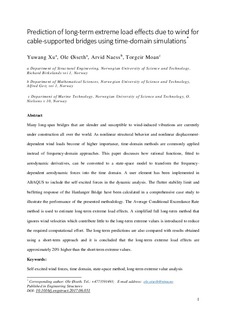| dc.contributor.author | Xu, Yuwang | |
| dc.contributor.author | Øiseth, Ole | |
| dc.contributor.author | Næss, Arvid | |
| dc.contributor.author | Moan, Torgeir | |
| dc.date.accessioned | 2017-10-25T14:50:47Z | |
| dc.date.available | 2017-10-25T14:50:47Z | |
| dc.date.created | 2017-10-23T11:30:09Z | |
| dc.date.issued | 2017 | |
| dc.identifier.citation | Engineering structures. 2017, 148 239-253. | nb_NO |
| dc.identifier.issn | 0141-0296 | |
| dc.identifier.uri | http://hdl.handle.net/11250/2462212 | |
| dc.description.abstract | Many long-span bridges that are slender and susceptible to wind-induced vibrations are currently under construction all over the world. As nonlinear structural behavior and nonlinear displacement-dependent wind loads become of higher importance, time-domain methods are commonly applied instead of frequency-domain approaches. This paper discusses how rational functions, fitted to aerodynamic derivatives, can be converted to a state-space model to transform the frequency-dependent aerodynamic forces into the time domain. A user element has been implemented in ABAQUS to include the self-excited forces in the dynamic analysis. The flutter stability limit and buffeting response of the Hardanger Bridge have been calculated in a comprehensive case study to illustrate the performance of the presented methodology. The Average Conditional Exceedance Rate method is used to estimate long-term extreme load effects. A simplified full long-term method that ignores wind velocities which contribute little to the long-term extreme values is introduced to reduce the required computational effort. The long-term predictions are also compared with results obtained using a short-term approach and it is concluded that the long-term extreme load effects are approximately 14% higher than the short-term extreme values. | nb_NO |
| dc.language.iso | eng | nb_NO |
| dc.publisher | Elsevier | nb_NO |
| dc.title | Prediction of long-term extreme load effects due to wind for cable-supported bridges using time-domain simulations | nb_NO |
| dc.type | Journal article | nb_NO |
| dc.description.version | submittedVersion | nb_NO |
| dc.source.pagenumber | 239-253 | nb_NO |
| dc.source.volume | 148 | nb_NO |
| dc.source.journal | Engineering structures | nb_NO |
| dc.identifier.doi | 10.1016/j.engstruct.2017.06.051 | |
| dc.identifier.cristin | 1506758 | |
| dc.description.localcode | This is a submitted manuscript of an article published by Elsevier Ltd in Engineering Structures, 30 June 2017 | nb_NO |
| cristin.unitcode | 194,64,45,0 | |
| cristin.unitcode | 194,63,15,0 | |
| cristin.unitcode | 194,64,20,0 | |
| cristin.unitname | Institutt for konstruksjonsteknikk | |
| cristin.unitname | Institutt for matematiske fag | |
| cristin.unitname | Institutt for marin teknikk | |
| cristin.ispublished | true | |
| cristin.fulltext | preprint | |
| cristin.qualitycode | 2 | |
